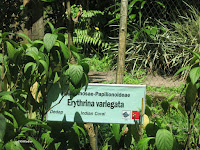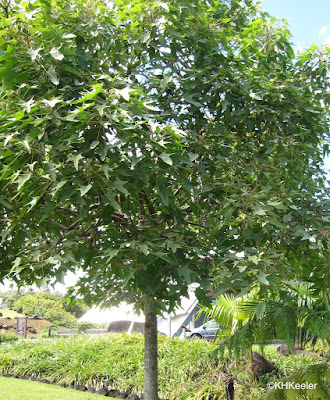 |
| Red-dyed yarn and cloth in Threads of Life shop, Ubud, Bali |
I thought I knew a lot about dyeing. I’ve grown most of the dye plants available commercially, for example madder, weld, and dyer's safflower, I've dyed with spinach, onion skins, red cabbage (link) and other fruits, vegetables and spices that have a reputations for producing dyes. I've thrown practically everything that grew in my garden, from marigolds to English ivy, into a dye pot and I've gathered wild plants from aspen and bindweed (link) to yarrow to make dyes.
 |
| Silk scarves I dyed in 2016 |
Doubtless you are thinking: of course there would be new plants, the native plants of the central U.S. are very different from Bali, in tropical Asia. And that's is part of it.
 |
| Erythrina variegata, Indian coral tree |

Despite my knowledge of dyeing, I walked the Threads of Life dye garden in Ubud, Bali, puzzled. There were so many plants marked that they were used to make a red dye (red square on the sign), and so few marked as making a yellow dye. For me, yellows are easy (blog): lots of different leaves make yellow dye when mordanted with alum and reds are difficult.
 |
| Morinda citrifolia, Indian mulberry, noni |
 |
| Morinda citrifolia, Indian mulberry sign and trunk |
But in southeast Asia, they didn't raise many sheep or wear wool. Silk was reserved for the wealthy or special occasions. Cotton was--and is--the fiber of choice. It can be woven wonderfully light, keeping one cool in the sticky tropical heat and humidity. But it is hard to get bright colors on cotton.
Indigo dyes cotton well, producing blue (see earlier post link). Some strong tannins from bark or roots will create a durable brown. But yellows are difficult. The garden reflected that. Very few plants were marked as being used for yellows. Historically the bark of soga tegeran (Maclura cochinchinensis, mulberry family Moraceae see earlier post: link), yelllow flambuoyant Peltophorum pterocarpum (pea family Fabaceae) and spurred mangrove, Ceriops tagal (mangrove family Rhizophoraceae) made a yellow, but those plants, the slow-growing soga tegeran in particular, have been over-harvested. The dye garden's signs described making yellow from the barks of the more abundant and rapidly growing jackfruit (Artocarpus heterophyllus) and mango (Mangifera indica), with a touch of turmeric root (Curcuma longa). Compared to simmering onion skins in alum water, both processes were more complex.
 |
| jackfruit, Artocarpus heterophylla |
 |
| wax jasmine, Jasminum simplicifolium |
 |
| Papaya, Carica papaya |
 |
| Carica papaya, papaya |
Papaya leaves, for example, were used to adjust the pH of dye baths when making red.
Reds on plant fibers (cotton and linen) pretty much eluded European dyers over history. They dyed wool red with madder or kermes (see cochineal blog) but not cotton or linen. Consequently, the reds of calicos and muslins (cottons) brought from India in the 1500s were a immediate sensation. Dyers in India didn't dye cotton red easily, on the contrary, they worked very hard at it, but they had mastered it. (historic calico pictures; early muslins pictures)
Asia had, in addition to a series of species of madder (Rubia), plants like Morinda citrifolia, called Indian mulberry and cheese fruit, noni in Hawaii (coffee family Rubicaceae), a small tree of tropical lowlands. Indian mulberry roots yield a red dye, but to attach that (or red from madder) to cotton required many steps. Cardon reported that dyeing cotton with Indian mulberry root powder in India included the minimum following steps: the fibers were oiled with castor oil (from Ricinus communis, spurge family Euphorbiaceae), treated with cow dung, and then strong lye, three to four times a day for a week. Meanwhile the bark power was boiled in water to make a dyebath. The yarn was throughly soaked in the dye bath, then more dye powder was laid directly added on the cotton threads and kneaded well for 10-15 minutes. The threads went back into the dye bath and were left in the sun for a day. The next day they were boiled in the dye bath again and then allowed to dry in the sun. The whole process, from lye treatment on, was then repeated a second time.
 |
| Ricinus communis, castor bean plant |
 |
| sappanwood, Caesalpinia sappan |
Another reason that I saw so many different plants used for making red dye was that different groups in southeast Asia used different plants in their formalae for red. I liked the idea that people in Bali and Java worked out comparable processes using different local plants.
I SO wished to have time to try all the variations and make all these colors. I had to settle for buying small samples of dried leaves to experiment with at home.
The result of a lot of work by the dyers of southeast Asia was a color palate for cotton and other plant fibers that featured deep blue, browns, and white, supplemented by reds, yellows and nearly black shades. They carefully applied those colors to the threads or dyed the cloth using batik or shibori methods to produce complex bright patterns (see earlier post link). In Europe, wool was the fiber of choice and the color palate there featured reds and red purples, medium to light blue, strong yellows, greens created by combining blue and yellow and natural wool browns and tans. White was rare because pure white wool was rare and good bleaches were slow to develop. Black was difficult but by the 1500s European dyers were creating rich blacks. All of this changed dramatically after 1856, when the invention of inexpensive aniline dyes broadened the available list of colors to the bright shades we have today and made natural dyes obsolete.
I was humbled to realize that what I knew about natural dyeing was so very regional, tied to the north temperate plants that grow around me and the widespread use of wool. A clear lesson is that other areas of the world, for example, Africa and South America, will reveal new insights into dyes and dyeing, because the fibers and available plants were and are different there. So much wonderful diversity in our world!
I again thank William Ingram and Made Maduarta for making me welcome to the dye garden on a day when, because of the Galungan holiday, it was officially closed, and Sterling Tours leader Cheryl Nichols for her help making connections.
Previous post about the Threads of Life Dye Garden link.
Comments and corrections welcome
Relevant posts from the A Wandering Botanist blog:
Yellows from many sources link
Dyeing with red cabbage link
Dye garden in Bali: blues and browns link
Mulberry dyes: Osage orange link and old fustic link
Reds from cochineal and other scale insects: link
References
Cardon, D. 2007. Natural dyes. Archetype Publications. London.
Sandberg, G. 1994. The red dyes: cochineal, matter and murex purple. Lark Books. Asheville, North Carolina.
 |
| candlenut, Aleurites moluccana |
 |
| candlenut, used as oil source in dyeing cotton red |
I was humbled to realize that what I knew about natural dyeing was so very regional, tied to the north temperate plants that grow around me and the widespread use of wool. A clear lesson is that other areas of the world, for example, Africa and South America, will reveal new insights into dyes and dyeing, because the fibers and available plants were and are different there. So much wonderful diversity in our world!
I again thank William Ingram and Made Maduarta for making me welcome to the dye garden on a day when, because of the Galungan holiday, it was officially closed, and Sterling Tours leader Cheryl Nichols for her help making connections.
Previous post about the Threads of Life Dye Garden link.
Comments and corrections welcome
Relevant posts from the A Wandering Botanist blog:
Yellows from many sources link
Dyeing with red cabbage link
Dye garden in Bali: blues and browns link
Mulberry dyes: Osage orange link and old fustic link
Reds from cochineal and other scale insects: link
References
Cardon, D. 2007. Natural dyes. Archetype Publications. London.
Sandberg, G. 1994. The red dyes: cochineal, matter and murex purple. Lark Books. Asheville, North Carolina.
Kathy Keeler, A Wandering Botanist
More at awanderingbotanist.com
Thanks for taking the time to discuss this, I feel strongly that love and read more on this topic. If possible, such as gain knowledge, would you mind updating your blog with additional information? It is very useful for me.
ReplyDeleteSilk Scarves UK